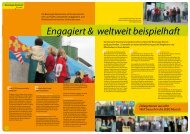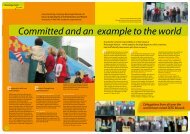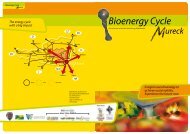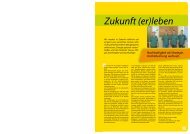Pages 3 to 21 - Seeg
Pages 3 to 21 - Seeg
Pages 3 to 21 - Seeg
You also want an ePaper? Increase the reach of your titles
YUMPU automatically turns print PDFs into web optimized ePapers that Google loves.
Bioenergie-Kreislauf<br />
ureck<br />
6,000<br />
5,000<br />
4,000<br />
3,000<br />
2,000<br />
1,000<br />
A pioneer on the road <strong>to</strong><br />
zero emissions<br />
Thanks <strong>to</strong> its collection<br />
system, SEEG ensured that<br />
9000 t less of used cooking<br />
oil entered the local<br />
sewerage system each year.<br />
Waste / wastewater:<br />
The SEEG collection system has not only<br />
prevented the sewerage system and<br />
wastewater treatment plants from damage<br />
and therefore greater expenditure:<br />
it has also helped people <strong>to</strong> realise that<br />
important raw materials can be reused<br />
for a useful purpose instead of being<br />
thrown away. SEEG has adopted an<br />
operational waste management scheme<br />
that enables it <strong>to</strong> process the highest<br />
possible amount of reusable waste. Its<br />
own production activities do not generate<br />
direct waste since the ash from local<br />
heating is used as a fertiliser, residue<br />
from filtering used cooking oil for composting<br />
and rapeseed cake for animal<br />
feed. In future, all biogenic waste will<br />
also be used <strong>to</strong> provide energy directly<br />
in the bio-gas unit. Hence Bioenergie<br />
Mureck is well on the way <strong>to</strong> becoming<br />
a zero-emissions plant. Paper, plastics<br />
and metals are properly captured so that<br />
only a small amount of residual waste is<br />
incurred.<br />
Rapeseed cake, eco-diesel and glycerine phase (GLP) production<br />
Soil / area requirements:<br />
The cultivation of rapeseed has improved<br />
the quality and compactness of the<br />
soil, leading <strong>to</strong> improved crop rotation. By moving<br />
away from single-crop farming, Bioenergie<br />
Mureck has managed <strong>to</strong> allay a frequently<br />
raised concern of the local population. This<br />
new approach will be reinforced by the<br />
planting of new crops (such as Sudan grass)<br />
for the biogas unit.<br />
Up <strong>to</strong> 890 ha of fields have been used <strong>to</strong> grow<br />
rapeseed. The production of biodiesel has<br />
clearly helped <strong>to</strong> reduce the level of environmental<br />
risk. The raw material requirements<br />
of Nahwärme Mureck have helped <strong>to</strong> ensure<br />
that 750 ha of forest are managed on a<br />
sustainable basis and kept in good health.<br />
Improvements in crop rotation have also<br />
been achieved thanks <strong>to</strong> the recently<br />
built biogas unit, which obviates the need for<br />
extra fertilisation with liquid manure. What’s<br />
more, bio-gas manure is kinder <strong>to</strong> crops and<br />
will eventually completely replace the use of<br />
mineral-based fertilisers. Apart from the liquid<br />
manure obtained from lives<strong>to</strong>ck farming,<br />
maize and green fodder are also used in the<br />
bio-gas unit.<br />
Ecological benefits:<br />
Ecological benefits are<br />
a <strong>to</strong>p priority<br />
• Reduction of emissions through<br />
more convenient local heating<br />
instead of domestic fires – now even<br />
with reduced costs.<br />
• Less traffic because more people can<br />
live and work in the region.<br />
• Lower emissions from biodiesel<br />
compared with fossil diesel<br />
(soot, SO 2 , fine particles).<br />
• Reduction of environmental hazards<br />
(diesel 70% degradable,<br />
bio-diesel 99.6%).<br />
• Reduction of climatically relevant<br />
greenhouse gases (only 15% indirect<br />
CO 2 emissions).<br />
• Utilisation of forestry residues and<br />
waste wood from the sawmills.<br />
0 1989 1990 1991 1992 1993 1 994 1995 1996 1997 1998 1999 2000 2001 2002 2003 2004 2005 2006<br />
1989 1990 1991 1992 1993 1 994 1995 1996 1997 1998 1999 2000 2001 2002 2003 2004 2005 2006<br />
------- Rapeseed cake production in t ----- Eco-diesel production in t ------- Glycerine phase Members Rapeseed area in ha Processing of used cooking oil in t<br />
Quantity per unit<br />
6,000<br />
5,000<br />
4,000<br />
3,000<br />
2,000<br />
1,000<br />
0<br />
• Less used cooking oil as problem<br />
waste in sewerage system and<br />
wastewater treatment plant.<br />
Members, rapeseed area in ha, processing of used cooking oil in t<br />
• Biogas unit is set <strong>to</strong> bring more crop<br />
friendly fertilisation and improved<br />
crop rotation.<br />
9189 t<br />
17









